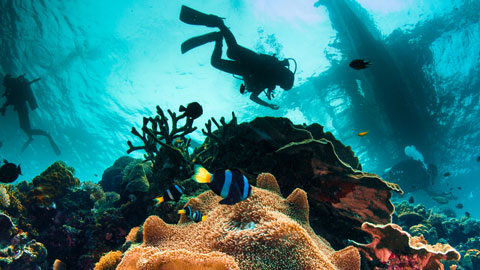Sea warming and acidification could make scuba diving areas less attractive

28/10/2015
Sea warming and acidification could turn unique parts of the Mediterranean in terms of biodiversity of species and habitats into environments that are less and less attractive for recreational purposes. A prime example of this is the potential impact of these environmental pressures on scuba diving areas with sea-floor corals and endemic species like the gorgonians, which include the iconic red coral. This is one of the findings of a study made by researchers from the Institute of Environmental Science and Technology (ICTA-UAB), indicating that the unprecedented increase in carbon dioxide caused by human activity since the Industrial Revolution could have an economic cost for sectors that depend on the sea for their living, in addition to its serious environmental costs.
The study was conducted in the Marine Protected Area of Medes Islands (Catalonia), located in the north-western Mediterranean, one of the Mediterranean areas that are most popular with scuba divers thanks to its great biodiversity and geomorphological complexity, and the presence of several emblematic species like red coral, grouper and skate.
The study, by Luís Camps Rodrigues, Jeroen van den Bergh and Sergio Rossi of ICTA-UAB, and also involving Maria Loureiro (University of Santiago de Compostela) and Paulo Nunes (PNUMA), was carried out as part of the European Union project, MedSeA. To calculate the potential losses associated with different warming and acidification scenarios, an environmental evaluation method known as a "choice experiment" was devised, to elicit and analyse the preferences of a sample of 390 divers with regard to different diving experiences.
This was used to evaluate factors that could impact on the divers' satisfaction, such as the geomorphological complexity of the sea floor, the potential deterioration of gorgonians (red coral, red gorgonians and white gorgonians) and greater presence of jellyfish, and also the number of people in each dive and the price of the activity.
The results show a possible decline in the popularity of Coralligenous areas with divers as a result of sea warming and acidification and the resulting fall in the population of gorgonians. The researchers calculate that a 50% fall in the gorgonian population would lead to economic losses in terms of divers' welfare of around 17 Euros per dive, while in a more extreme case – local extinction of the species – there would be a loss of approximately 60 Euros per dive. The rise in numbers of stinging jellyfish was also seen to have a negative effect on divers' welfare, with a loss of 26 Euros per dive.
The study also estimated the rates of rejection of diving on the part of divers in different scenarios. In the case of theoretical drops of 50% and 100% in the gorgonian population, the rejection rates reached 16% and 27.6% respectively.
The economic costs described in this study are associated above all with a reduction in divers' welfare. However, they could also involve losses of income for tourist operators, a fall in financial support for protected areas if this is linked to fees paid for diving, and a fall in indirect income and employment in the local economy. The researchers claim that the economic effects could be even greater if we take into account the effects of global warming and ocean acidification on other Coralligenous species, such as calcifying algae and stony corals, and repercussions in the entire ecosystem.
Research paper:
Rodrigues L.C., van Den Bergh J.C.J.M., Loureir M.L., Nunes P.A.L.D., Rossi S. "The Cost of Mediterranean Sea Warming and Acidification: A Choice Experiment Among Scuba Divers at Medes Islands, Spain". Environmental and Resource Economics. 2015, p. 23